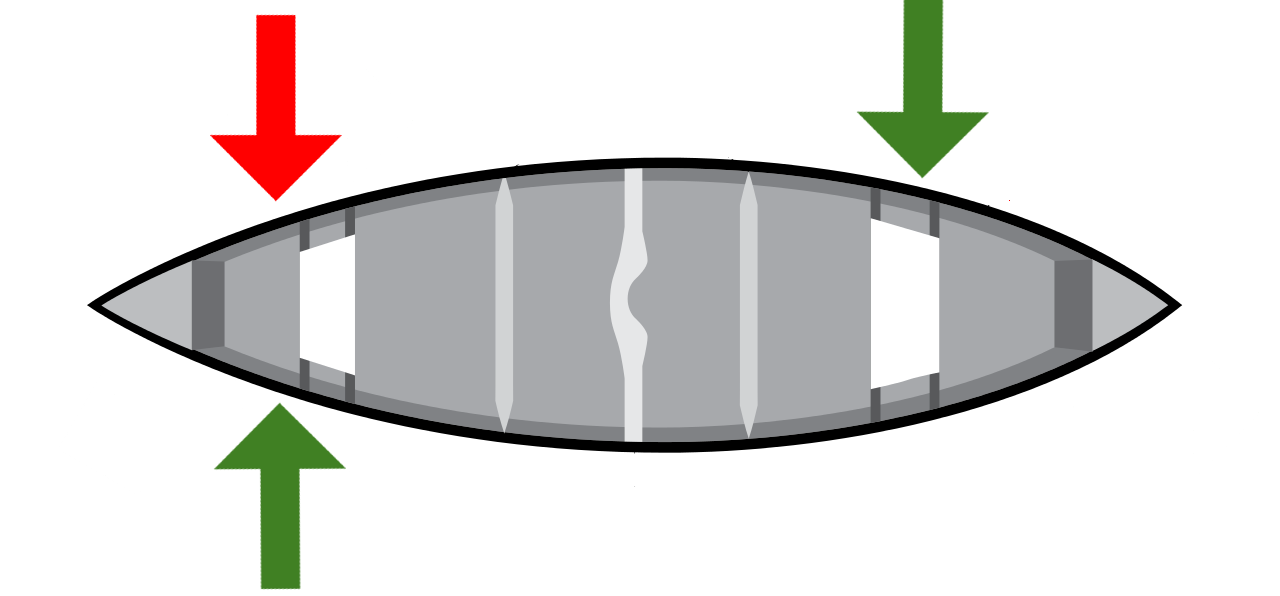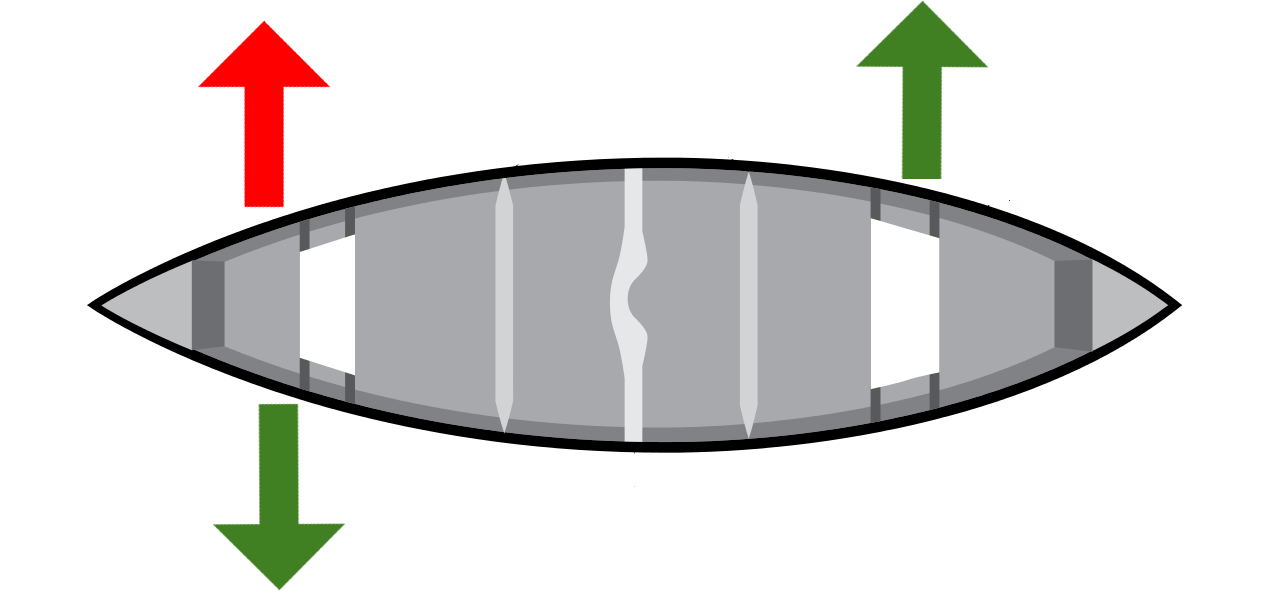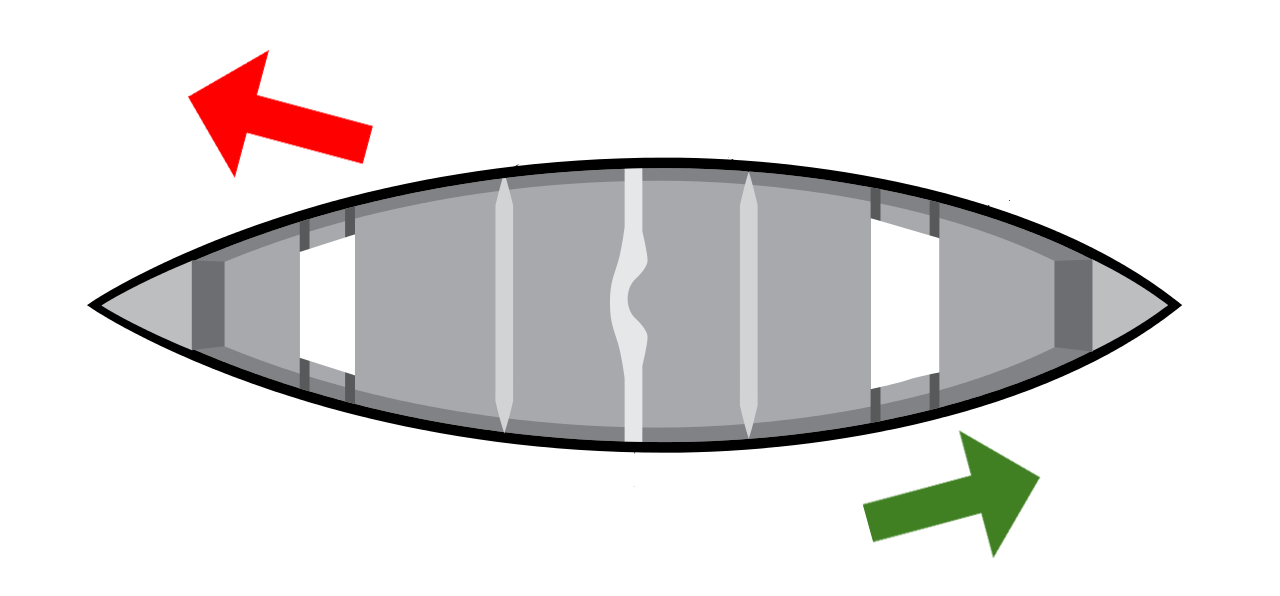Leverage
[lev-er-ij]
noun
- the mechanical advantage or power gained by using a lever5
Controlling the Canoe
The utilization of leverage is an integral part of controlling the canoe.
Particular strokes of the paddle apply different forces to the canoe, either pushing or pulling to cause the bow to point in the desired path of travel.
There are four basic strokes, each meant to move the canoe in a different direction.
In the examples below the red arrow represents the force of the stroke while the green arrow represents the approximate direction of travel.
The Forward Stroke
The forward stroke is the basic stroke used in canoeing, as it propels the boat almost straight forward. By reversing the direction in which the paddle moves the stroke can also move the canoe backwards, or slow it down.
In the two diagrams below the canoes are moving towards the right of the screen using the forward stroke.

 In the case of the canoe on the left the individual in the stern is paddling on their left, this causes a slight movement in the bow towards the right, which, combined with the current pushes the canoe to the right.
The force of the water, especially when travelling up stream, can quickly force the bow of course quite forcefully due to the leverage the water exerts on the bow.
The canoe on the right however will travel straight, this is because the long narrow body of the canoe is acting much like a trailer being pulled. The force is being exerted in front of the pivot point causing the canoe to trail behind in a straight path.
In the case of the canoe on the left the individual in the stern is paddling on their left, this causes a slight movement in the bow towards the right, which, combined with the current pushes the canoe to the right.
The force of the water, especially when travelling up stream, can quickly force the bow of course quite forcefully due to the leverage the water exerts on the bow.
The canoe on the right however will travel straight, this is because the long narrow body of the canoe is acting much like a trailer being pulled. The force is being exerted in front of the pivot point causing the canoe to trail behind in a straight path.
The Draw Stroke
The draw stroke is meant to quickly turn the canoe about its center of rotation.
The stroke is compleated by pulling the paddle towards you with the blade of the paddle parallel to the length of the canoe.
 Generally the stearing is done by the individual in the back, as a more minor adjustment in the rear will have a greater effect overall.
In the example above the individual in the stern is drawing the paddle towards themself, moving the rear of the canoe towards the top of the page and thus pushing the front of the canoe towards the bottom of the page.
Generally the stearing is done by the individual in the back, as a more minor adjustment in the rear will have a greater effect overall.
In the example above the individual in the stern is drawing the paddle towards themself, moving the rear of the canoe towards the top of the page and thus pushing the front of the canoe towards the bottom of the page.
The Pry Stroke
The pry stroke is used for the same reasons as the draw stroke and follows the same process, however the stroke goes away from the canoe and moves the bow in the opposite direction.
 As the paddle moves away from the canoe the force it exerts pushing against the water forces the rear of the boat down towards the bottom of the page. As this occurs the front of the canoe moves towards the top of the page, creating movement in the counter-clockwise direction.
As the paddle moves away from the canoe the force it exerts pushing against the water forces the rear of the boat down towards the bottom of the page. As this occurs the front of the canoe moves towards the top of the page, creating movement in the counter-clockwise direction.
The J Stroke
In my experiance the J stroke is the most useful of the four main types of stroke.
Unless the paddler in the bow is exceptionally strong the canoe has a tendancy to drift towards the side of the boat oppisite of that that the individual in the rear is paddling on.
By first paddling parallel to the length of the canoe and then flairing out away from the canoe at the end, the bow moves towards the side of the canoe that the rear paddler is on.
This counteracts the clockwise movement of the forward stroke.

Images on this page from Wikipedia
7 heavily edited by G.M. Sheets